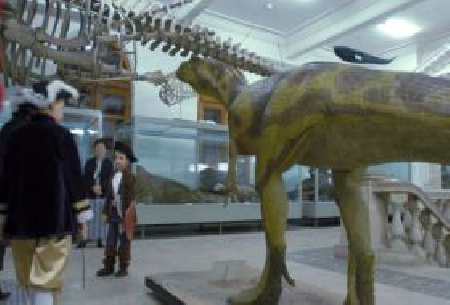The Grigore Antipa Museum of Natural History
The natural history museum is the capitals most popular museum, out of a string of museums scattered along the avenue that links the government building in the center to the northernmost regions of Bucharest. The museum building has an interesting histor

Eugen Cojocariu, 29.04.2012, 17:44
The natural history museum is the capital’s most popular museum, out of a string of museums scattered along the avenue that links the government building in the center to the northernmost regions of Bucharest. The museum building has an interesting history overlapping with the modernization of the Romanian territories.
On November the 3rd 1834, ruler Alexandru Ghica founded the National Museum of Natural History and Antiquities. The initiative belonged to the ruler’s brother, Mihalache Ghica, who also became the first donor of the museum enriching its collections with ancient coins, minerals, shells, mammals and fossils. Along the years, the museum has changed several locations and directors, but the one who identified himself most with this institution was scholar Grigore Antipa, who headed it from 1893 until his death in 1944. His contemporaries decided to name the museum in his honour.
Ioana Matache, director with Antipa Museum told us more about the building: “The museum has been functioning on the same premises since 1908; the building was erected upon the initiative and under the guidance of Grigore Antipa himself, between 1904 and 1906; he conceived it in a special manner in order to be able to house a museum and its vast collections. It was the first construction built for a special purpose in Romania, and is now a historic monument. The façade was designed by architect Grigore Cherchez, who also included a group of statues entitled “The Science”, carved by sculptor Dimitrie Paciurea, which unfortunately were razed down by the 1940 earthquake.”
The museum opened in its present location on May the 24th 1908 and its centennial was celebrated in 2008 with the inauguration of a project aimed at the complete restoration of the premises. Following 3 years of restoration works, the National Museum of Natural History reopened its gates on September the 17th, this year.
Here is what visitors can see: “In the semi-basement, there is a diorama of animals living in various regions across Romania. The country is divided into five bioregions, out of Europe’s total 11 and we are proud to be the richest EU country in terms of bioregions. On the ground floor there is a diorama representing the planet’s biodiversity, from the northernmost, arctic points to the hottest regions on earth. It’s like a journey through the globe’s regions and habitats. On the first floor, visitors can admire the world’s sea giants, as well as the life-size skeleton of a whale, ten and a half meters in length. The second floor hosts the office of scholar Antipa, a room with various rocks and fossils on view and we have devoted an entire space to insects; we have insects from all over the world, over 1 million species.”
Among the unique exhibits of the Antipa Museum there is also the skeleton of a giant elephant, which was added to the collection in 1911 and dates back some 5.3 million years.
Here is Ioana Matache with more details about this interesting animal: “This is the skeleton of Deinotherium gigantissimum, a unique species of elephants, which was discovered by Gregoriu Stefanescu in late 19th century in Vaslui, northeastern Romania. After the skeleton was completely restored a new species was discovered, which the contemporaries named ‘Awesome animal’. And that’s exactly how it was at that time with 4.5 meters in height and 3.5 meters in length. The animal used to roam marshes and ingurgitate huge quantities of leaves and branches. Its tusks grow from its lower jawbone unlike its modern relatives. We also have on view the huge skeleton of an American mastodon; its sizes are impressive indeed. And we have a very rare skeleton of the DO-Do bird, some sort of a giant pigeon with small wings and an enormous beak. It used to live in Madagascar and Mauritius until these islands were settled and the species went extinct.”
Besides the well-represented local fauna – which includes species of rare or extinct animals — the Antipa Museum in Bucharest is also home to a lizard-fish fossil, perfectly adapted to sea life, which dates back to the Mesozoic era.





























